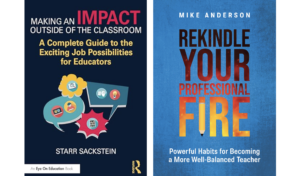Inequities Hidden in Plain Sight: School Supplies

Do you care about equity in your school? Do you believe that all children should have a fair chance at school success?
It’s common for grade levels or departments to create long lists of supplies that students are expected to bring to school on the first day back from summer break. As classroom teachers, we each struggled with these practices in the schools where we taught. Each of our families have also experienced this first-hand. These lists usually included basic school supplies such as pencils, pens, and notebooks as well as more specific (and expensive) items such as 3-ring D-binders and clear plastic pocket sheets for portfolios. In high school, it was assumed that they had phones to play class games (such as Kahoot!) and laptops to do daily work. When they took the SAT and PSAT they were required to bring in their own pencils and were encouraged to bring in their own approved calculators.
As we’ve worked in schools all over the US, we’ve seen this common practice.
If having students bring in supplies is such a common practice, what’s the big deal? How does this contribute to inequity?
For many families, spending upwards of $50 or $100 (or more) on school supplies in August is a significant challenge. Often times this cost may take away from daily necessities or from funds allocated for bills. In schools where this is a common practice, most children may bring these supplies in each year, so it appears as though families can handle this burden. Indeed, many can. Others may manage to scrape up the money needed or take away from basic needs to do so. But, there’s no way they will subject themselves to the shame of letting the school know how hard it was.
 Others may not be able to afford the supplies. Or, they may not have a car so they can’t easily get to an office supply store on the other side of town. Some caregivers may struggle with reading information sent home from schools. For some, getting kids’ school supplies simply doesn’t rise to the top of the survival list on any given day. Let’s also not forget that for many families who have multiple children in school, there will be multiple lists, each with different supplies to manage. The bill could easily top $200—the equivalent of a couple of weeks’ worth of groceries.
Others may not be able to afford the supplies. Or, they may not have a car so they can’t easily get to an office supply store on the other side of town. Some caregivers may struggle with reading information sent home from schools. For some, getting kids’ school supplies simply doesn’t rise to the top of the survival list on any given day. Let’s also not forget that for many families who have multiple children in school, there will be multiple lists, each with different supplies to manage. The bill could easily top $200—the equivalent of a couple of weeks’ worth of groceries.
What happens when kids can’t get these supplies? Perhaps they have older siblings and can use their old junky beaten-up binders and half-dried out markers. Imagine how that feels—to sit down in class and see other kids taking out shiny new binders and opening packages of new colored pencils and protractors. For others, they show up to school with no supplies at all. If they’re lucky, a kind adult will quietly bring them some used supplies left over from last year (which is still embarrassing). If they’re unlucky, a teacher might accuse them of being irresponsible and unprepared for the new year, failing to consider the impact of their harsh accusation. Imagine the potentially irreparable shame and humiliation this could cause. The message is clear for these children. In this school, there are haves and have-nots. It’s the first day of school and you’re already getting the message that you don’t measure up.
For teachers who have grown up in, and continue to live in middle class settings, this may not even be on our radar. We have such fond memories of back-to-school shopping from our childhoods, or we continue to love to shop for new clothes and supplies with our own children. It’s such a rite of passage and a marker of the new school season. When reconsidering moving away from having families provide school supplies, we might cringe at the idea of taking away this back-to-school ritual from families. It’s important to recognize that this worry is seen through the lens of our own experience, not the experiences of many of our most vulnerable children.
What could we do instead?
- Schools should provide all supplies needed for school success. This simple policy would be a good place to start. It might mean that certain supplies would have to be adjusted. For example, instead of using D-ring binders to organize research materials, use pocket folders instead. Include materials needed in budgets and cut back on supplies that the school won’t pay for.
- Use community supplies in the classroom. Consider having the rule that any supplies that are in the classroom are open for everyone to use. Have common supplies that are shared by all. If students have special supplies that only they (and their three best friends) will be allowed to use, they should keep them at home.
- Apply for grants. If a certain unit or project requires expensive supplies, try applying for grants or ask local businesses to support the project. Some PTAs and PTOs offer in-school grants to support special projects. You might also consider using crowd funding sites like donorschoose.org or www.adoptaclassroom.org.
- Invite families to donate supplies and/or money. Want to give families with means the chance to go back-to-school shopping? Send home a list of commonly needed supplies that families can donate if they want. Or, invite families to donate money to be used for special projects or materials. Many families will love the chance to support the classroom!
A Final Note…About Field Trips
It’s our recommendation that you consider these same ideas and principles when it comes to field trips. Do you have some field trips at your school that are optional—and that families have to pay for if they opt in? Do families risk embarrassment and shame in your school by having to ask for reduced rates if they can’t afford to pay full price for a trip? How might you create a level playing field so that all kids have the same access to these important learning opportunities?
We have experienced both sides of this dynamic coin. One of us had the good fortune to afford some expensive trips for his children. Writing a check for an unforgettable band trip to China was manageable (though this was not always the case). The other’s children attended an independent school in which his family benefitted from tuition assistance. His children benefitted from going on immersive learning experiences to Spain and Costa Rica . However, this school had a system that automatically provided help for high-ticket experiences, like trips and prom tickets, to families that received tuition assistance. Neither required the family to ask.
What about families that straddle the line between these two situations? On paper, they do not qualify for assistance. However, writing a four-figure check to support one of the aforementioned trips is not always reasonable. Many schools have an “if you need help just let us know” policy. Yet, this requires families to humble themselves and actually ask. Not everyone is willing to do so. The result is a missed experience for their child—and an inequitable school experience. How can we avoid this? We know that the path to the answer is not an easy one.
We’d love to hear what you think about the ideas in this post. Please share your ideas in the comments box below and pass this post along to other educators (or parents, school board members, administrators, etc.) who might benefit from it.
Read about more inequities common in many schools in our other posts in this series!
Inequities Hidden in Plain Sight (Common School Practices that Disadvantage the Already Disadvantaged)






Comments
I agree wholeheartedly with all of these.
I’m frustrated though at the expectation that if a student doesn’t have something, I, as their teacher, should provide it. Pencils and food are the only ones listed in the article, but I have been asked many times through the PTA, or school, to give cash and clothes/hygiene items/coats/shoes…etc.
Sorry not sorry, but my own child comes first. I am not going to compromise his experience because I am socially expected to provide for children who are not mine.
I don’t have a solution at and I guess am just complaining, but teachers are also struggling financially.
No doubt, teachers shouldn’t be asked to spend their own personal money on students’ supplies! If the school expects students to have something, the school should supply it. I’m shocked at the idea of a PTA suggesting that teachers should provide these things!